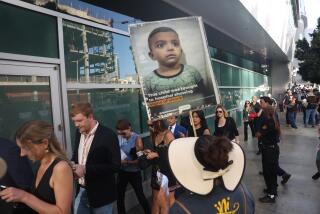Twin Marches Culminate in Rally for Tibet Freedom
- Share via
One group marched from San Francisco--through the redwoods of Big Sur, the artichoke fields of Salinas, the rolling hills of San Simeon. Another walked from San Diego--through the posh streets of La Jolla and the beach town of Encinitas.
But both had the same cause: Tibetan independence from China.
After two months and nearly 700 miles combined, the two groups hooked up for the first time Tuesday in a Santa Monica ceremony of song, prayer and political appeals. The marches were timed to coincide with a visit by His Holiness the Dalai Lama of Tibet to Los Angeles this week and will culminate Saturday outside the Chinese Consulate.
The marchers say they’re trying to inform Americans in a direct and personal way about religious persecution and political oppression in Tibet. Activists say that during the five decades of Chinese occupation of Tibet more than 6,000 Buddhist monasteries have been destroyed and that 600 political prisoners are currently being detained.
“For people who don’t know anything about Tibet, the march builds awareness in an immediate way,” said Julie Crow, an organizer from Indianapolis who has participated in similar marches since 1995.
Tibetan Buddhist monastics Palden Gyatso and Ani Pachen Dolma each led one of the California treks. Although there were only about 40 marchers in all, they were welcomed in Santa Monica by a rally that attracted about 200 supporters.
Crow said they have had a tangible impact, winding their way through small towns and sharing Tibet’s story with people who have never even heard of the place.
They’ve passed out Spanish-language literature to farm workers in the Central Valley. They’ve spoken from pulpits, at potlucks and before college crowds in Berkeley, Stanford, Monterey.
They’ve even conducted a bit of personal diplomacy. In Venice on Tuesday, the group clustered in front of a soon-to-be-opened Chinese restaurant, Mao’s Kitchen, and engaged the owner in a talk about Tibet.
“I’m not sure about independence,” said restaurateur Yanzhong Li, who emigrated from China eight years ago, “but I do have a lot of sympathy for Tibetan people and think their culture should be better preserved.”
The monks in saffron robes, women in Tibetan traditional dress, fluttering flags and drums have gotten honks of support from motorists, thumbs-up signs from surfers, calls of “cool!” from passersby. Strangers have offered them money, water, food, even shoes, said Pema Lhundrup, general secretary of the 17,000-member Tibetan Youth Congress, who flew in from India to participate in the marches.
Church members--including Quakers, Methodists, Unitarians and Episcopalians--have fed and housed the marchers, offered them showers and cleaned their clothes. Churches also hosted community forums on the Tibet issue.
Dolma, known as Tibet’s “warrior nun,” has shared her story of leading the resistance against the Chinese as the only child of a powerful chieftain from Tibet’s eastern district of Kham. For that, she spent 21 years in Chinese prisons. She was released in 1981 and fled Tibet in 1988.
Clearly, however, the marchers have work to do. As the procession wound its way down the Venice boardwalk Tuesday, past skaters and cyclists and hunks at Muscle Beach, a few passersby clapped but most ignored them.
Tom Porceddu, for instance, watched the procession pass his Venice tattoo stand with bemusement. He said he’s vaguely heard of the Dalai Lama. He’s heard that actor Richard Gere is “really involved.” He’s seen that movie with Brad Pitt--what was it? “Seven Years in Tibet”? But no, he doesn’t know anything about Tibet’s struggle for independence and doesn’t particularly care.
“There’s so much going on in my life,” he said. “I’m not interested in what’s going on in somebody else’s life.”
Among marchers, however, the cause has stirred them to refinance homes, quit jobs and use their vacations to join the walk. Participants range from age 12 to 70. They’ve come from India, Sweden, New York, Irvine.
Charette Hebbard, 20, quit her educational program sales job at Columbia University to make the march. From the time she was 5, she said, she heard stories about Tibet from her American neighbors who spent time in the region on Buddhist retreats. The older she got, the more she felt compelled to take action.
Crow, too, has taken time from her job as a special education tutor--not once but four times. She’s walked from Bloomington to Indianapolis. Toronto to New York. Portland to British Columbia. And now San Francisco to Santa Monica. “I believe in the concept of engaged Buddhism: If you see suffering, you do something about it,” she said.
More to Read
Sign up for Essential California
The most important California stories and recommendations in your inbox every morning.
You may occasionally receive promotional content from the Los Angeles Times.













